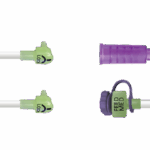The AMT Bridle Pro®: Revolutionizing Nasogastric Tube Securement Since 2004
For over two decades, AMT has relentlessly fixated on optimizing the comfort, safety, and ease of nasogastric and nasointestinal tube bridling. Through tube size tweaks, magnet strength enhancements, clip revisions, and filament refinements, the Bridle Pro® has evolved into what it is today; the nasal tube securement system that clinicians prefer.
Methodically designed to benefit both the patient and the clinician, the Bridle Pro® addresses and overcomes common challenges within nasal bridling such as streamlining insertion and securement, minimizing pullout risks and complications, avoiding patient injury, and decreasing hospital costs.
Let’s explore why millions of healthcare professionals choose the Bridle Pro®.
Ease of Insertion & Securement
Designed by clinicians for clinicians, the Bridle Pro® was developed to create an efficient workflow during insertion. With easily lubricated probes and a pre-attached tube securement clip, the device is able to be placed in under a minute without patient sedation or use of restraints.
Clinically proven and FDA cleared for both pediatrics and adults, the AMT Bridle™ Family features a full range of sizes to accommodate any brand of nasogastric feeding tube as small as 5 French up to 18 French.
The Bridle Pro® features narrow, flexible probes that are easily lubricated, making placement pain-free and seamless in even the smallest patients. These intuitive qualities, along with a soft filament designed to resist snagging on plastics or other materials even without lubrication, make nasal bridling significantly easier and more comfortable.
After placement, the patient’s nasogastric tube is then secured to the bridle with a soft clip, reducing the risk of slippage and providing an MR-safe solution to tube dislodgement and other complications associated with nasal feeding tubes.
Diminishing Pullout Risks & Associated Complications
40% of all nasogastric feeding tubes are dislodged, leading to health setbacks such as:
- Aspiration
- Pneumothorax
- Radiographic exposure
- Sinusitis
- Interruptions in nutritional support
Recurring tube dislodgement can devolve into early, and many times unnecessary, surgical placement of a feeding device or conversion to parenteral nutrition support.
In addition to possibly causing needless PEG or TPN intervention, accidental dislodgement of a nasogastric feeding tube also often leads to:
- Wasted formula
- Tube replacement
- Secondary x-rays or imaging
- Hospital-acquired conditions from tube migration
- Longer hospital stays
While tube dislodgement incidents have plagued clinicians and patients for decades, the Bridle Pro® has been shown to reduce pullout occurrences by 72%. Securing around the strong vomer bone dramatically minimizes cases of injury, as it discourages patients from pulling on their tubes.
Moreover, there has been no documented increase in incidents of sinusitis associated with the bridle after being placed in hundreds of thousands of patients, making the Bridle Pro® the ultimate tool for safe tube retention.
Avoiding Patient Injury
Along with associated insertion dangers and pullout risks, conventional methods of tube securement often provoke:
- Skin breakdown
- Allergic reaction from harsh adhesives
- Nasal septal damage
- Pressure necrosis
Skin Breakdown & Irritation
The Bridle Pro® secures and organizes medical tubing, eliminating the risk of painful skin irritation caused by tape or other adhesives.
However, for some patients, the sensation of a feeding tube near their mouth can be uncomfortable. In these cases, clinicians can use the CINCH® – a low-profile, breathable securement device featuring soft silicone and hypoallergenic adhesive – to keep tubing away from the mouth while providing gentle protection for even the most delicate skin.
Pressure Injuries
In addition to diminishing skin irritation, the soft, round filament of Bridle Pro® significantly reduces the risk of pressure injuries caused by pulling on the tube. Designed to distribute force under pressure, the filament will completely flatten to avoid cutting into the tissue of the nasal septum if pulled upon.
While the pressure created on the vomer bone creates a ‘brain freeze’ sensation strong enough to discourage most patients from pulling on their tube, many patients being placed with nasogastric feeding tubes are in extreme discomfort, and will continue to pull on the device regardless of negative reinforcement. With these patients in mind, all components of the Bridle Pro® are designed to break before injury can occur.
Detached Clips as Choking Hazards
Another common concern with nasal bridling are detached clips that pose choking risks during initial placement or if the patient is on oxygen. Many times with detached clips, a cloth or cover must be placed over the recipient’s mouth during bridle placement to ensure the clip is not dropped into the mouth. Similarly, bridles with detached clips must often be removed if a patient needs to go on oxygen, as there is concern of the clip entering the mouth and causing aspiration.
The attached clip feature on all devices within the AMT Bridle™ Family nearly neutralizes the threat of aspiration, providing a safe and worry-free nasal bridling option for patients on oxygen and eliminating the need to cover the patient’s mouth during initial placement.
In addition to being pre-attached to the bridling filament, our Bridle Pro® clips are fully encased in a soft material, allowing them to resist slippage even when used with lubrication.
Minimizing Hospital Costs
While the patient is always top of mind at AMT, we also recognize our responsibility of cutting medical costs to benefit both the device recipient and the caretaker.
Tube dislodgement and related complications are the root of inflated hospital expenses, as they cause a domino effect of wasted time and resources:
- Clinician must replace the tube
- Secondary x-ray & fluoroscopy must be done to ensure proper placement
- Formula and other supplies must be replaced
- Length of hospital stay is extended due to suboptimal nutrition
- Hospital acquired conditions may develop from tube migration
Use of the Bridle Pro® on each and every nasogastric tube within a care center has been shown to catalyze significant savings – from clinician time to shorter length of stays – ultimately producing a healthier, happier patient.
According to an approximate cost analysis, the Bridle Pro® can save over $400 in hospital expenses after just one tube replacement. After two or even three pullout incidents, the cost benefits become even more evident.
| Item | 1 Tube Replacement (USD) | 2 Tube Replacements (USD) | 3 Tube Replacements (USD) |
| Feeding Tube | $26 | $52 | $78 |
| X-Ray | $340 | $680 | $1,020 |
| Radiologist Read | $35 | $70 | $105 |
| Nursing Time | $28 | $56 | $84 |
| Total Cost | $429 | $858 | $1,287 |
*Information taken from multiple sources
Looking Forward
Altogether, the benefits of the Bridle Pro® are seemingly endless – streamlined insertion and securement, minimized pullout risks, decreased patient injury, extreme cost efficiency, and so many more.
Through AMT’s tireless commitment to intuitive refinement and patient success, the Bridle Pro® has become the trusted nasal tube securement system of clinicians worldwide. With every refinement – design, material, or functionality – we reaffirm our dedication to our valued partners, our clinical champions, and our treasured patients.
Learn more about the AMT Bridle™ Family and why clinicians believe the Bridle Pro® should be used with every tube, every time.
Disclaimer: Anything contained in this blog is general information only and is not, nor should it be interpreted to be, medical advice. Always consult with a qualified physician and/or a health care provider for medical advice.
References
Gunn SR, Early BJ, Zenati MS, Ochoa JB: Use of a Nasal Tube Bridle Prevents Accidental Nasoenteral Feeding Tube Removal. JPEN Journal of Parenteral and Enteral Nutrition 2009: 33(1): 50-54
Seder CW, Janczy R. The Routine Bridling of Nasojejunal Tubes is a Safe and Effective Method of Reducing Dislodgement in the Intensive Care Unit. NCP Nutrition in Clinical Practice. 2008-2009:23(6) 651-654


